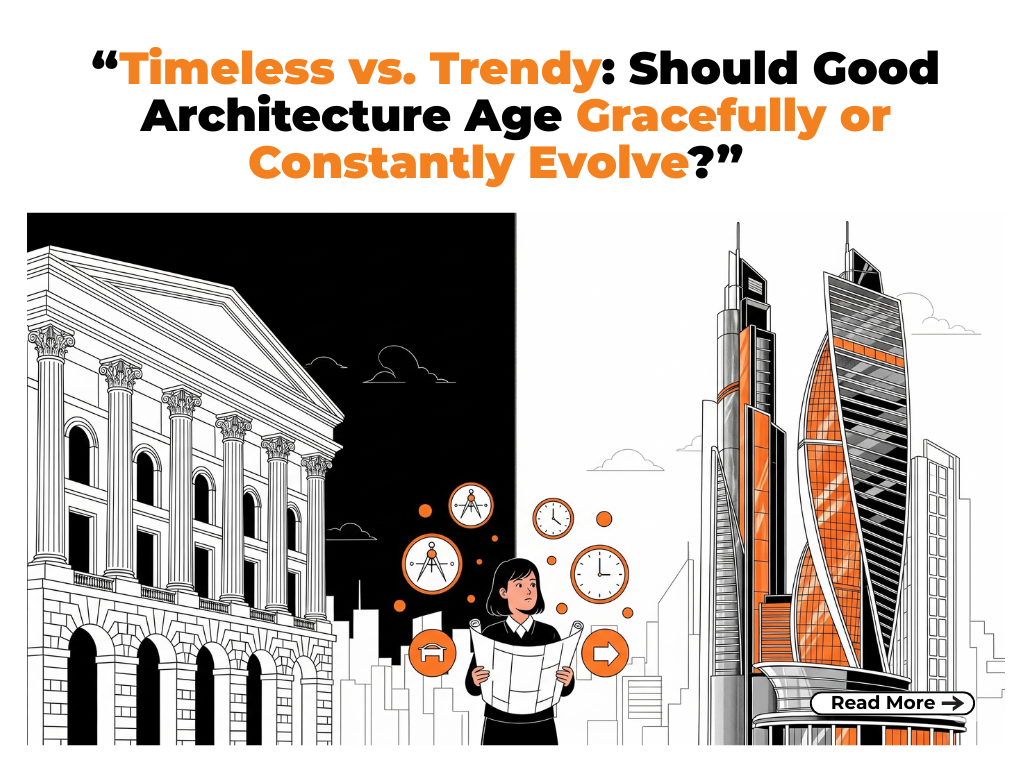Walk through any historic city and you’ll feel it — that quiet sense of awe when centuries-old cathedrals, palaces, or humble old townhouses stand tall beside glass-clad towers and edgy angular museums. It’s a dance of eras: the graceful endurance of timeless design meeting the restless spirit of the trendy. In this delicate tension lies one of architecture’s most enduring debates: Should good architecture be timeless — aging gracefully and dignifying the skyline for generations — or should it always mirror the restless pulse of contemporary culture?
In understanding the present, it’s vital to explore the evolution of architecture, a timeline marked by shifting aesthetics, needs, and values that influence how and why we build.
The answer, as with most things in design, is not black and white. But let’s unpack both sides of the argument, and perhaps find a middle ground where architecture serves not just today’s needs but tomorrow’s dreams too.
The Case for Timelessness
Timeless Bachelor of Architecture whispers stories long after their makers are gone. Think of the Pantheon in Rome, the Hagia Sophia in Istanbul, or closer to modern times, the restrained elegance of Louis Kahn’s works or the enduring simplicity of Mies van der Rohe. These buildings are more than structures; they are cultural anchors, telling us who we were and inviting us to reflect on who we are.
A timeless building transcends fashion. Its proportions, materials, and purpose are so well considered that they feel right in any decade. Such architecture relies less on decorative trends and more on universal principles: harmony, balance, light, and the honest expression of materials.
More importantly, timeless buildings often prioritize adaptability. A well-designed historic house or civic building can be reimagined and reused many times over. This longevity supports sustainability: to reuse is to reduce waste and preserve resources — something the planet desperately needs.
As the modern world grapples with the environmental cost of constant tearing down and rebuilding, timeless architecture reminds us that durability is not just aesthetic; it is ecological responsibility.
The Case for Trendy
But architecture, if only timeless, risks becoming fossilized — a beautiful relic disconnected from the dynamic societies it shelters. Imagine a city that clings only to the past: how would it accommodate new technologies, changing work patterns, or the evolving spirit of its people?
Trendy, contemporary architecture thrives on challenging conventions. It experiments with new forms, bold materials, and emerging ideas about how humans live and interact. Frank Gehry’s swirling titanium, Zaha Hadid’s fluid geometries, or Bjarke Ingels Yes is More — these statements push the discipline forward.
When done well, trendy architecture sparks dialogue and reinvents urban experience. It reminds us that cities are living organisms, not static museum exhibits. The so-called “starchitecture” of the last few decades may be polarizing, but it has undeniably expanded the language of design, making space for innovation and imagination.
Moreover, trendy architecture often responds more quickly to contemporary crises. Net-zero buildings, adaptive facades, or experimental co-living hubs are rarely born from a purely classical mindset. They demand a designer who is tuned into what the world needs now.
Here, architectural evolution becomes crucial, allowing innovation to coexist with culture, and experimentation to support human well-being without losing touch with the past.
A False Dichotomy?
So, must we really choose between timeless and trendy? Perhaps the real artistry lies in reconciling the two.
Architecture can draw deeply from enduring principles — proportion, light, human scale — while embracing innovation in materials and technology. A building can feel rooted and forward-looking at once. Think of Tadao Ando’s tranquil concrete churches: minimalist and modern yet timeless in their purity. Or the adaptive reuse of industrial warehouses into chic co-working hubs — old bones, new life.
Cities thrive when they are palimpsests: layers of time visible in the streetscape. The interplay of old and new invites us to appreciate continuity and change. Preservationists and avant-garde designers need not be adversaries; in fact, they need each other. The old lends the city soul; the new keeps it awake.
What Should Guide Us?
As architects, planners, and citizens, the question should not be “Timeless or trendy?” but “What does this place, its people, and the planet need most right now — and decades from now?”
Sometimes, the answer is restraint: to restore rather than replace, to build with materials that weather beautifully rather than scream for attention. Other times, the answer is boldness: to challenge tired typologies and spark new ways of living, working, or gathering.
Good architecture does not chase trends for the sake of novelty, nor does it mimic the past in fear of the future. It is thoughtful, rooted in context, yet alive to possibilities.
In Closing: Beauty that Lasts, Ideas that Grow
Perhaps the buildings we admire most are those that age gracefully and evolve gracefully. They don’t ossify; they adapt. They don’t shout for relevance; they earn it through quality and responsiveness.
So let us build cathedrals and skyscrapers, cozy courtyards and daring museums — but above all, let us design with the humility that our work will outlive us, and the courage to let it change when it must.
In that delicate balance lies architecture’s true legacy: beauty that lasts, ideas that grow, and a cityscape that tells the story of humanity — timeless and forever trending.
From heritage restoration and heritage building restoration to embracing architecture evolution and the evolution of forms of architecture, our cities thrive when we blend memory with momentum, honoring the past while shaping a bold, thoughtful future.
What do you think? Should good architecture lean toward the timeless or the trendy? Share your thoughts below — let’s build this conversation together.














